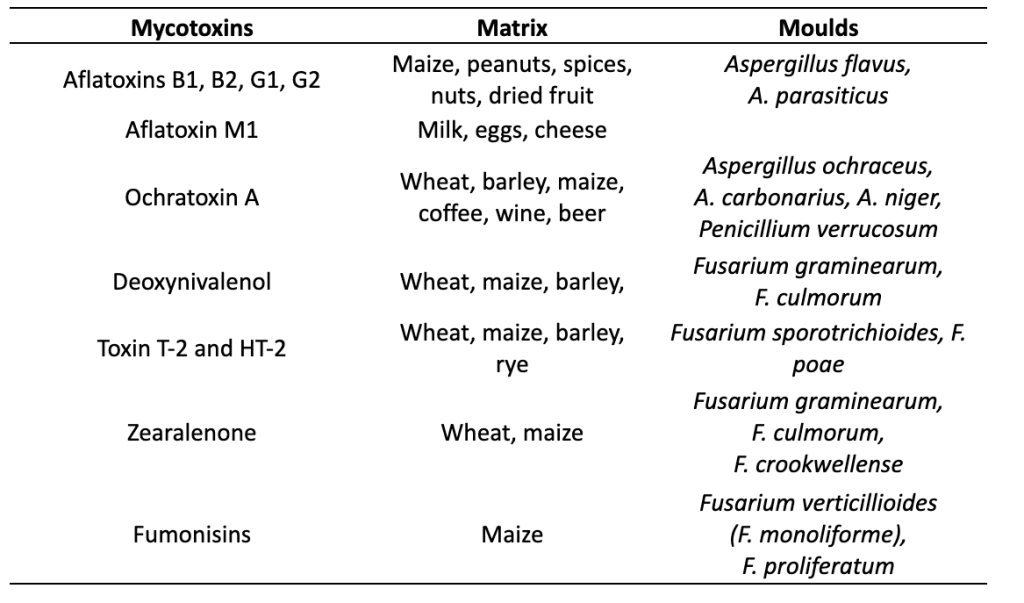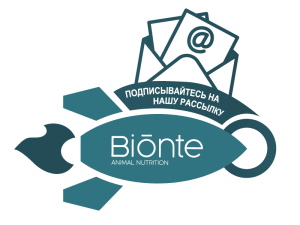Introduction
Mycotoxins are toxic secondary metabolites produced by different strains of filamentous fungi (molds), such as Aspergillus, Fusarium and Penicillium (EFSA, 2020). However, it is often possible to find several toxins in the same matrix, whether intended for human or animal consumption. Their toxicity is so high that they can induce pathologies that are extremely harmful to human health, such as alterations in gastrointestinal function, immune function and cancer (Schrenk et al., 2020a).
Molds that produce these highly harmful compounds are able to grow under various conditions, which significantly increases exposure (depending on the quantity and frequency). The latter parameter is closely related to the risk of developing mycotoxicosis (Völkel et al., 2011). Mycotoxicoses are acute and chronic intoxications caused by exposure to mycotoxins.
If cultivation or storage conditions are not optimal, molds can synthesize mycotoxins which, if ingested by the consumer, lead to so-called primary mycotoxicosis. In other cases, the consumer may suffer from this intoxication through the consumption of animal products (e.g. meat, milk or eggs), known as secondary mycotoxicosis (Figure 1; Bhat, 1997).

**Adapted from Bhat, 1997 and Sanchís et al., 2004.
Figure 1*. Differences between primary and secondary mycotoxicosis.
The fate of a mycotoxin in an organism is the result of the processes of absorption, tissue transport, biotransformation and excretion, which in the case of animals includes the transfer of these metabolites to animal products. The transfer of undesirable compounds from contaminated feed to edible animal tissues or by-products is commonly known as carry-over (Völkel et al., 2011).
Mycotoxin converted form found in animal products include hydroxylation, oxidation, hydrogenation, methylation, glycosylation and glucuronidation, esterification, hydrolysis, sulphation, demethylation and deamination reactions (Li et al., 2020).
Mycotoxins that have received most attention due to transfer from feed to animal products are aflatoxins (AFB1 and AFM1), ochratoxin A (OTA), zearalenone (ZEN), fumonisins (FB1+FB2), toxin 2 (T2) and HT-2 toxin (Table 1; Tolosa et al., 2021).

Table 1. Main mycotoxins in food (feed and food) and their producing fungi.
Occurrence of mycotoxins in animal products
The presence of mycotoxins in animal products, together with viral and bacterial agents, represent one of the greatest threats to the safety, hygiene and quality of foodstuffs for human consumption. The matrices that may be contaminated by these compounds are listed below.
Milk
One of the most studied cases of carry-over is perhaps the hydroxylated metabolite AFM1, which is originated from aflatoxin B1 (AFB1) and is very often found in milk and its derivatives (Gonçalves et al., 2020; Tolosa et al., 2021). It has been widely demonstrated that aflatoxins and their metabolites affect all animal species, including small ruminants. Another important point is its high stability, which has been mitigated by the use of heat treatments (e.g. UHT and pasteurization; Mohamadi and Alizadeh, 2010).
With regard to the metabolites found in milk and its derivatives, although to a much lesser extent, the converted OTα form of ochratoxin A by rumen microbiota has also been detected in milk (Hashimoto et al., 2016).
Becker-Algeri et al. (2016) described the presence of other mycotoxins, such as fumonisins, zearalenone and deoxynivalenol, in milk and its derivatives.
Concerning fumonisins, the studies that have been carried out indicate that there is a low transfer of this mycotoxin and its metabolites (Flores-Flores et al., 2015). Similarly, zearalenone has been detected in milk (Flores-Flores et al., 2015) as well as in milk powder, although it does not represent a hazard to human health as its concentrations were very low (Huang et al., 2014). With respect to deoxynvalenol, only its less toxic form DOM-1 has been detected in milk and milk products (Tolosa et al., 2021).
It should be noted that in recent years, studies in milk have shown the presence of the emerging and modified mycotoxins bauvericin (BEA) and enniantin (ENN), thereby confirming their carry-over. For example, low levels of enniantin have been detected in milk samples in sheep (Piatkowsja et al., 2018). Carry-over of these mycotoxins has also been confirmed in human studies. However, studies in cows have not shown the presence of these mycotoxins in their milk (Krízova et al., 2021).
Meat and meat by-products
Similar to milk, meat and meat by-products can be subject to carry-over contamination. In this regard, studies that have been carried out to evaluate the presence of mycotoxins in this category of products indicate that in fresh meat and animal organs the toxins that are most present are aflatoxins, ochratoxin A, fumonisin and zearalenone (Meucci et al., 2019; Hort et al., 2020). On the other hand, the most frequently reported mycotoxins in cured and fermented meat products are ochratoxin A and aflatoxins (AFs).
Aflatoxin contamination in meat and meat products has been widely studied, especially in pigs and poultry, since they are the group most affected by mycotoxins due to the structure of their simple (non-specialized) digestive system, which allows them to most mycotoxins enter their active form.
On the other hand, the carry-over levels described in ruminants are lower than monogastric, due to the detoxification process of mycotoxins both in the rumen, and at the level of hepatic metabolism (Tolosa et al., 2021).
In pigs, low concentrations of AFs have been detected in their products due to their hepatic metabolism, while in poultry a metabolization of the same to aflatoxicol in the liver has been detected, although they do not represent a threat to human health (Tolosa et al. al., 2021).
Ochratoxin A (OTA) is one of the most important mycotoxins in these products, as it is frequently detected in edible tissues and pork by-products (Stoev et al., 2002).
As for the other mycotoxins, zearalenone and its metabolite α-ZEL have been detected in sausages and in pork liver and meat (Pleadin et al., 2015b). Finally, the presence of fumonisins FB1 and FB2 in sausages and pork livers should be noted (Zhao et al., 2015).
Emerging mycotoxins (BEA and ENN) have been detected in turkey and broiler tissues, which raised speculation of a possible carry-over from feed. The highest prevalence of ENN and other metabolites were found in serum and liver of broilers (Kˇríˇzova et al., 2021).
Fish
The carry-over of mycotoxins in aquaculture is not as well studied as the other products previously mentioned. However, in the comprehensive review by Tolosa et al. (2021), there is information on the mycotoxins of interest to the sector. The fish organs with the highest concentration of mycotoxins are liver, kidneys and edible muscles.
Mycotoxins with the highest accumulation in the mentioned organs and tissues are aflatoxin B1, deoxynvalenol and fumonisins (Tolosa et al., 2014; Bernhoft et al., 2017). However, depending on the species studied, the accumulated concentrations may differ.
For example, in atlantic salmon (Salmo salar), the carry-over of deoxynivalenol to muscles and kidneys is very significant compared to sea bream (Sparus aurata), which is absent (Pietsch et al., 2014; Nácher-Mestre et al., 2015). On the other hand, atlantic salmon do not show carry-over of zearalenone, or its metabolites in muscles, while rainbow trout (Oncohynchus mykiss) accumulate this mycotoxin in the intestine, liver and ovaries (Nácher-Mestre et al., 2020).
Regarding emerging mycotoxins, several studies have highlighted the presence of the mycotoxin ENN in farmed fish, such as sea bass (Dicentrarchus labrax) and sea bream (Sparus aurata), particularly in the thighs and liver (Tolosa et al., 2014).
Eggs
The consumption of mycotoxin-contaminated feed by chickens causes several health problems and leads to significant economic losses in terms of egg quality and quantity. Common mycotoxins found in eggs are aflatoxins, ochratoxin, zearalenone and fumonisins (Greco et al., 2014; Jia et al., 2016). Furthermore, it has been shown that a combination of AFs and ZEA in feed synergistically reduces laying performance, egg quality and feed intake of laying hens (Jia et al., 2016). Finally, some authors have shown the presence of ENN B1 (Jetsoi et al., 2009).
Conclusions
The transfer of mycotoxins to animal products is a major problem that can affect food safety and quality as well as human and animal health. To reduce and prevent contamination by molds and the transfer of their secondary metabolites to animal products, the establishment of safe levels of exposure to mycotoxins and recommendations for good agricultural and feed manufacturing practices, as well as the use of high quality, species- and phase-specific anti-mycotoxins products, represent the efficient solution to reduce and prevent contamination by molds. Thus, preventing also the transfer of their secondary metabolites into products of animal origin.



